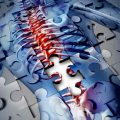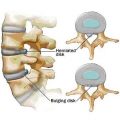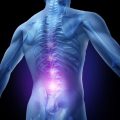Table of Contents
Bulging Disc Overview
Bulging discs alone are not necessarily painful. As a matter of fact, 30 to 60% of patients with asymptomatic bulging seen on MRI scans may not experience at all. However, the MRI scan alone is doesn’t automatically diagnose the cause of pain for bulging disc. This is why doctors will often use multiple tests; and imaging scans to better understand the condition of the spine and make the proper diagnosis.
Proper diagnosis is of course; crucial for the course of treatment, as treatment vary depending on what is causing the pain. After locating the problematic spinal disc and assessing its condition, physicians may recommend different options, or combinations of different treatments. Treatment usually starts with conservative methods. Especially if the bulging disc causes mild to moderate pain that resolves on its pain after a couple of days of rest. For the worsening cases however; doctors will most definitely recommend more aggressive approach to treat the problem and address its debilitating symptoms.
Spine specialists like orthopedic spine surgeon or physiatrists may also come into play, especially for cases that needs aggressive treatment.
Initial and Conservative Treatment Options for Bulging Disc
Conservative and initial treatments are non-invasive treatments used to alleviate pain and promote spine health and mobility. Some of the most commonly used treatment methods are physical therapy, and spine manipulation (with a chiropractor). Doctors may also prescribe NSAIDs (non-steroidal anti-inflammatory drugs) to manage pain.
Other recommendations include:
- A specified period of rest
- Avoidance of activities that puts pressure on the neck and back, such as lifting heavy objects
- Ice packs
- Heat therapy, warm showers
- Lifestyle changes such as weight loss
- Stretching exercises (especially designed by a physical therapist)
- Targeted exercises especially (especially designed by a physical therapist)
- Pain relievers and over-the-counter anti-inflammatory medications
- Epidural steroid injections (cortisone injections)
Surgical Treatments for Bulging Disc
If those conservative treatments mentioned above have don’t seem solve the bulging disc problem, especially the pain, even after the course of several months of treatment, then it’s time for more aggressive methods.
Study shows that only 10% of bulging disc patients may need surgical intervention. But surgery is crucial to patients suffering from disruptive symptoms such as weakness, severe pain, tingling sensation, and numbness, that won’t simply go away. The idea of surgical procedures for bulging disc is to release compression on the affected nerve. It is important to help patients get back on their daily activities and live a normal life, free of pain and function with better mobility.
However, it is worth to note that spine disc surgery can be a sophisticated process and may require lengthy hospital stay. The surgery will make multiple large incisions, which entails grueling recovery period. This is why most good doctors will only see them as last resort.
Some hospitals however, have minimally invasive techniques for spine surgeries, such as laser treatment procedures. Some surgeries are even offered for outpatient basis, eliminating the inconvenience of hospital stays and allowing patients to get back in their lives sooner.






 I love to write medical education books. My books are written for everyone in an easy to read and understandable style.
I love to write medical education books. My books are written for everyone in an easy to read and understandable style.